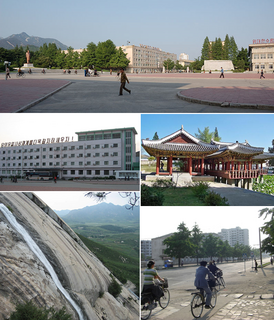Sariwŏn Ch'ŏngnyŏn Station is the central railway station of Sariwŏn, North Hwanghae province, North Korea. It is on located on the P'yŏngbu Line, which was formed from part of the Kyŏngŭi Line to accommodate the shift of the capital from Seoul to P'yŏngyang; though this line physically connects P'yŏngyang to Pusan via Dorasan, in operational reality it ends at Kaesŏng due to the Korean Demilitarized Zone. It is also the northern terminus of the Hwanghae Ch'ŏngnyŏn Line.
Ch'imch'on Ch'ŏngnyŏn Station (Chosŏn'gŭl: 침촌청년역) is a passenger railway station located in Ch'imch'ol-li, Hwangju County, North Hwanghae Province, North Korea. It is on located on the P'yŏngbu Line, which was formed from part of the Kyŏngŭi Line to accommodate the shift of the capital from Seoul to P'yŏngyang; though this line physically connects P'yŏngyang to Pusan via Dorasan, in operational reality it ends at Kaesŏng due to the Korean Demilitarized Zone.
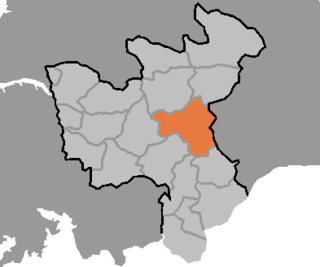
Sin'gye County is a county in North Hwanghae province, North Korea. It is a mining district with abandoned molybdenum and copper mines.

The P'yŏngbu Line is an electrified standard-gauge trunk line of the Korean State Railway running from P'yŏngyang to Kaesŏng in North Korea and further south across the DMZ to Seoul in South Korea; the name comes from the two (theoretical) termini of the line: P'yŏngyang and Pusan.
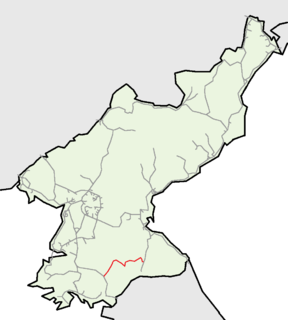
The Ch'ŏngnyŏn Ich'ŏn Line is an electrified standard-gauge secondary mainline of the Korean State Railway running from P'yŏngsan on the P'yŏngbu Line to Sep'o on the Kangwŏn Line. The 141.3 km (87.8 mi) line is the southernmost of the three east-west transversal mainlines in North Korea.
Ch'ŏngjin Ch'ŏngnyŏn Station is the central railway station in Ch'ŏngjin-si, North Hamgyŏng Province, North Korea. It is the junction point of the Hambuk Line and the P'yŏngra Line of the Korean State Railway, and is the beginning of the Ch'ŏngjinhang Line to Ch'ŏngjin Port.

The Hwanghae Ch'ŏngnyŏn Line is an electrified standard-gauge secondary line of the Korean State Railway in the North and South Hwanghae provinces of North Korea, running from Sariwŏn to Haeju. It connects to the P'yŏngbu Line at Sariwŏn, to the Ŭnnyul Line at Ŭnp'a, to the Paech'ŏn Line at Changbang, and to the Ongjin Line at Haeju. It plays an important role in the transportation of freight and passengers in North and South Hwanghae provinces, serving important mining and industrial areas, as well as one of the DPRK's most important ports for foreign trade.

The Ŭnnyul Line is a non-electrified standard-gauge secondary line of the Korean State Railway in the North and South Hwanghae provinces of North Korea, running from Ŭnp'a to Ch'ŏlgwang. It is an important line in economic terms, connecting the agricultural and ore-producing areas of Kwail and Ŭnnyul counties with the rest of the DPRK.

The Paech'ŏn Line is a partially electrified standard-gauge secondary railway line of the Korean State Railway in South Hwanghae Province, North Korea, running from Changbang on the Hwanghae Ch'ŏngnyŏn Line to Ŭnbit.
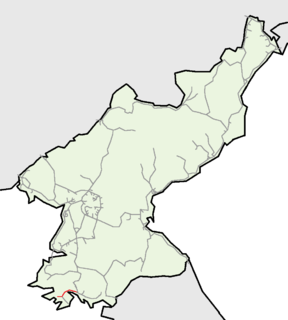
The Ongjin Line is a partially electrified standard-gauge secondary line of the Korean State Railway in South Hwanghae Province, North Korea, running from Haeju on the Hwanghae Ch'ŏngnyŏn Line to Ongjin.
Hyesan Ch'ŏngnyŏn Station is the central railway station of Hyesan city, located in the Ch'un-dong neighbourhood of greater Hyesan city, Ryanggang province, North Korea. A large station with seven tracks, it is the junction point of the Korean State Railway's Paektusan Ch'ŏngnyŏn and Pukpu lines.

Hoeryŏng Ch'ŏngnyŏn Station is a railway station in Hoeryŏng-si, North Hamgyŏng, North Korea, on the Hambuk Line of the Korean State Railway. It is also the starting point of the 10.6-km-long freight-only Hoeryŏng Colliery Line to Yusŏn-dong, Hoeryŏng-si.
Namp'o Station is a railway station in Hanggu-guyŏk, Namp'o Special City, North Korea on the P'yŏngnam Line of the Korean State Railway, as well as the starting point of the Tojiri Line. There is an engine house northwest of the station in Munhwa-dong, Hanggu-guyŏk.
Ŭnp'a Station is a railway station in Ŭnp'a-ŭp, Ŭnp'a County, South Hwanghae Province, North Korea, on the Hwanghae Ch'ŏngnyŏn Line of the Korean State Railway. It is also the eastern terminus of the Ŭnnyul Line.
Changbang Station is a railway station in Changbang-ri, Haeju City, South Hwanghae Province, North Korea, on the Hwanghae Ch'ŏngnyŏn Line of the Korean State Railway. It is also the western terminus of the Paech'ŏn Line.
The Pongsan Line is an electrified freight-only railway line of the Korean State Railway in Pongsan County, North Hwanghae Province, North Korea, running from Pongsan on the P'yŏngbu Line to West Pongsan,
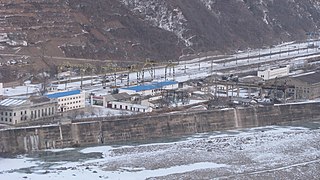
Kuunbong Station is a freight-only railway station in Unbong-rodongjagu, Chasŏng County, Chagang Province, North Korea; adjacent to the Chasŏng Dam on the Yalu River, it is the terminus of the Unbong Line of the Korean State Railway.
Unbong Station is a railway station in Unbong-rodongjagu, Chasŏng County, Chagang Province, North Korea, on the Pukpu Line of the Korean State Railway.
The Chŏngdo Line is an electrified standard-gauge secondary line of the Korean State Railway in South Hwanghae Province, North Korea, running from Wangsin on the Ongjin Line to Chŏngdo.
